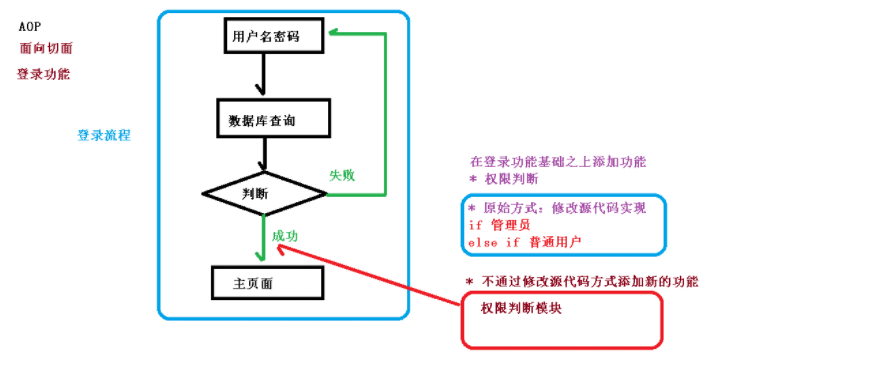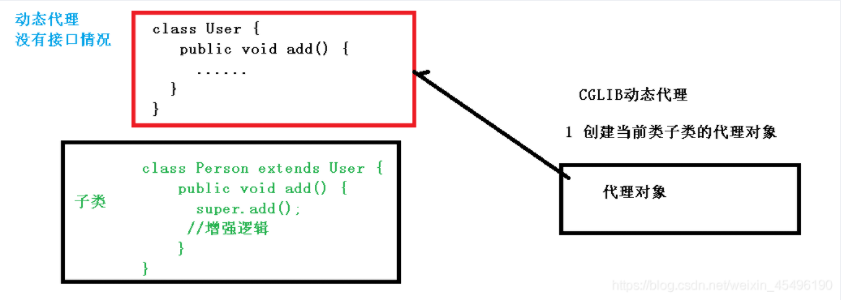AOP 基本概念
(1)面向切面编程(方面),利用 AOP 可以对业务逻辑的各个部分进行隔离,从而使得 业务逻辑各部分之间的耦合度降低,提高程序的可重用性,同时提高了开发的效率。
(2)通俗描述:不通过修改源代码方式,在主干功能里面添加新功能
(3)使用登录例子说明 AOP

AOP(底层原理)
a)AOP 底层使用动态代理 ,动态代理有两种情况:
第一种 有接口情况,使用 JDK 动态代理 ;
创建 接口实现类代理对象 ,增强类的方法
这样如果想要新增内容

第二种 没有接口情况,使用 CGLIB 动态代理 ;
创建 子类的代理对象 ,增强类的方法

AOP(JDK 动态代理)
1)使用 JDK 动态代理,使用 Proxy 类里面的方法创建代理对象
1
2
3
4
5
|
public static Object newProxyInstance(ClassLoader loader,
Class<?>[] interface,InvocationHandler h)
|
2)编写 JDK 动态代理代码
1
2
3
4
5
6
7
8
9
10
11
12
13
14
15
16
17
18
19
20
21
22
23
24
25
26
27
28
29
30
31
32
33
34
35
36
37
38
39
40
41
42
43
44
45
46
47
48
49
50
51
|
class Duck implements Fly,Yuck{
@override
fly(){}
@override
yuck(){}
}
interface Fly{
fly();
}
interface Yuck{
yuck();
}
class SpeakDuck implements InvocationHandler{
private Object obj;
public SpeackDuck(Object obj){
this.obj = obj;
}
@override
public Object invoke (Object proxy,Method method,Object[] args)
throws Throwable{
method.invoke(obj,args);
}
@override
yuck(){
speak();
}
speak(){
System.out.println("I can speak")
}
}
public class JDKproxy{
public static void main(Stringp[ args){
Class[] interfaces = {Fly.class,Yuck.class};
Duck duck= new Duck;
Yuck speakingDuck =(Yuck)Proxy.newProxyInstance(
JDKProxy.class.getClassLoader(),interfaces,new SpeakDuck(duck));
speakingDuck.yuck();
}
}
|
AOP(术语)
a)连接点:类里面哪些方法可以被增强,这些方法称为连接点
b)切入点:实际被真正增强的方法称为切入点
c)通知(增强):实际增强的逻辑部分称为通知,且分为以下五种类型:
1)前置通知 2)后置通知 3)环绕通知 4)异常通知 5)最终通知
d)切面:把通知应用到切入点过程
AOP操作
a)Spring 框架一般都是基于 AspectJ 实现 AOP 操作,AspectJ 不是 Spring 组成部分,独立 AOP 框架,一般把 AspectJ 和 Spirng 框架一起使 用,进行 AOP 操作
b)基于 AspectJ 实现 AOP 操作:1)基于 xml 配置文件实现 (2)基于注解方式实现(使用)
c)引入相关jar包
d)切入点表达式,如下:
1
2
3
4
5
6
7
8
9
10
| (1)切入点表达式作用:知道对哪个类里面的哪个方法进行增强
(2)语法结构: execution([权限修饰符] [返回类型]
[类全路径] [方法名称]([参数列表]) )
(3)例子如下:
例 1:对 com.atguigu.dao.BookDao 类里面的 add 进行增强
execution(* com.atguigu.dao.BookDao.add(..))
例 2:对 com.atguigu.dao.BookDao 类里面的所有的方法进行增强
execution(* com.atguigu.dao.BookDao.* (..))
例 3:对 com.atguigu.dao 包里面所有类,类里面所有方法进行增强
execution(* com.atguigu.dao.*.* (..))
|
AOP 操作(AspectJ 注解)
1
2
3
4
5
6
7
8
9
10
11
12
|
public class User {
public void add(){
}
public class UserProxy{
public void before(){}
}
}
|
1
2
3
4
5
6
7
8
9
10
11
12
13
14
15
|
<?xml version="1.0" encoding="UTF-8"?>
<beans xmlns="http://www.springframework.org/schema/beans"
xmlns:xsi="http://www.w3.org/2001/XMLSchema-instance"
xmlns:context="http://www.springframework.org/schema/context"
xmlns:aop="http://www.springframework.org/schema/aop"
xsi:schemaLocation="http://www.springframework.org/schema/beans http://www.springframework.org/schema/beans/spring-beans.xsd
http://www.springframework.org/schema/context http://www.springframework.org/schema/context/spring-context.xsd
http://www.springframework.org/schema/aop http://www.springframework.org/schema/aop/spring-aop.xsd">
<context:component-scan base-package="com.atguigu.spring5.aopanno"></context:component-scan>
<aop:aspectj-autoproxy></aop:aspectj-autoproxy>
</beans>
|
1
2
3
4
5
6
7
8
9
10
11
12
13
14
15
16
17
18
19
20
21
22
23
24
25
26
27
28
29
30
31
32
33
34
35
36
37
38
39
40
41
42
43
44
45
46
|
@Component
@Aspect
public class UserProxy {
@Pointcut(value = "execution(* com.atguigu.spring5.aopanno.User.add(..))")
public void pointdemo() {
}
@Before(value = "pointdemo()")
public void before() {
System.out.println("before.........");
}
@AfterReturning(value = "execution(* com.atguigu.spring5.aopanno.User.add(..))")
public void afterReturning() {
System.out.println("afterReturning.........");
}
@After(value = "execution(* com.atguigu.spring5.aopanno.User.add(..))")
public void after() {
System.out.println("after.........");
}
@AfterThrowing(value = "execution(* com.atguigu.spring5.aopanno.User.add(..))")
public void afterThrowing() {
System.out.println("afterThrowing.........");
}
@Around(value = "execution(* com.atguigu.spring5.aopanno.User.add(..))")
public void around(ProceedingJoinPoint proceedingJoinPoint) throws Throwable {
System.out.println("环绕之前.........");
proceedingJoinPoint.proceed();
System.out.println("环绕之后.........");
}
}
|
1
2
3
4
5
6
|
@Component
@Aspect
@Order(1)
public class PersonProxy{ }
|
AOP 操作(AspectJ 配置文件)
1
2
3
4
5
6
7
8
9
10
11
12
13
14
15
16
| <!--1、创建两个类,增强类和被增强类,创建方法(同上一样)-->
<!--2、在 spring 配置文件中创建两个类对象-->
<!--创建对象-->
<bean id="book" class="com.atguigu.spring5.aopxml.Book"></bean>
<bean id="bookProxy" class="com.atguigu.spring5.aopxml.BookProxy"></bean>
<!--3、在 spring 配置文件中配置切入点-->
<!--配置 aop 增强-->
<aop:config>
<!--切入点-->
<aop:pointcut id="p" expression="execution(* com.atguigu.spring5.aopxml.Book.buy(..))"/>
<!--配置切面-->
<aop:aspect ref="bookProxy">
<!--增强作用在具体的方法上-->
<aop:before method="before" pointcut-ref="p"/>
</aop:aspect>
</aop:config>
|
总结
1.Aop注解的方式
AOP注入依赖的这个AspectJ只是一种AOP的实现方式,以后可能会有其他的实现相似的功能。其核心还是开启注解,开启AOP,之后只需标识增强方法和被增强的方法即可。
2.Aop配置文件方式
创建增强类和被增强类,之后创建AopConfig。
配置切入点—-被增强类需要增强的方法
配置切面
配置切面引用为增强类
配置各类方法,并加上其切入点引用


